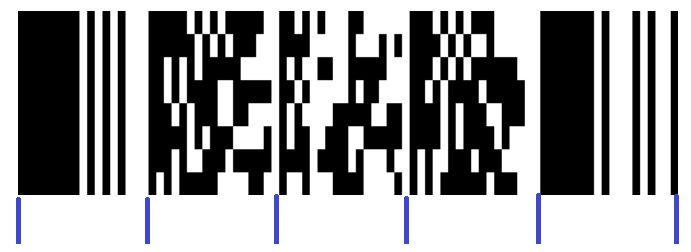If you want to insert a PDF417 barcode in a template, then you need to insert a barcode element, then you need to select it as the barcode type, after you have selected the barcode element:

The parameters are:
(The headers are links to the common description).
The data, that you want to put into the barcode.
Here you can enter a text constant for the data, that you want to use for the barcode in the result view in the designer.
The width of the small squares of the barcode. This is rounded to up to a whole number of dots in the selected output resolution (DPI). For the mime types, ZPL and Direct protocol the resolution/DPI is set on the printer and for PCL/PDF output the resolution is set on the template element in the template.
The ratio between the height and width of the small boxes/modules, that make up the barcode. A ratio of two means, that the boxes/modules are twice as high as they are wide. The module ratio is rounded up to the possible ratio given the selected output resolution (DPI). Not all ratios are possible as it is not possible to print a part of a dot. For the mime types, ZPL and Direct protocol the resolution/DPI is set on the printer and for PCL/PDF output the resolution is set on the template element in the template.
State if the barcode should have a fixed width or fixed height.
COLUMNS means, that the width is fixed, and is the set as the number of data blocks in the width of the barcode.
ROWS means, that the height is fixed, and the height is set as a number of boxes/modules.
Sets the width or the height depending on the layout direction.
For COLUMNS it sets the width as the number of data blocks.
For ROWS it sets the number of boxes/modules in the height.
The error correction of the barcode i.e. how error proof or redundant the barcode is to be. The larger the value the larger the barcode will be.
How InterFormNG2 should react, if the data used cannot be converted into the barcode e.g. because of unsupported characters.
Set a fixed width for the PDF417 barcode
If you want to set a fixed width for a PDF417 barcode, then you need to set the layout direction mentioned above to COLUMNS. The full width of the PDF147 barcode depends on two settings above: 1) The module width and 2) The number of columns.
The PDF417 barcode consists of multiple sections. Each section is marked with a blue line below:

In the sample barcode above there are 5 sections:
1.The first part is the start pattern, which is 17 modules wide.
2.The second part is the Left row indicator, which is also 17 modules wide.
3.The third part is the Data codeword. The number of data codewords is what you setup in the parameter, Number of columns (still assuming, that the layout direction is COLUMNS). Each data codeword is 17 modules wide. The number of columns must be at least 1.
4.The fourth part is the Right row indicator, which is 17 modules wide.
5.The final and fifth part is the stop pattern, which is 18 modules wide.
So you can calculate the width of the complete barcode in this manner:
Module width* (17*(3+number of columns)+18)
If e.g. the module width is 20/1000 inches and the number of columns is set to 2, then the width of the PDF417 barcode is:
0.020*(17*(3+2)+18) inches= 0.020*103 inches = 2.06 inches = 5.23 cm.
If in the other way you know how wide the barcode should be (while the module width is fixed to 20/1000), then you can calculate the number of columns like this:
(Barcode width/Module size -69)/17
If we e.g. want a barcode width of 4.4 cm (same as 1.73 inches), then we can calculate the number of columns as:
(1.73/0.020-69)/17 = 17.5/17 = 1.029. This means, that number of columns should be 1.
If this calculation results in a negative value, then it is not possible to generate such a slim barcode with the selected module width.
Set a fixed height for the PDF417 barcode
If we want to set a fixed height for the PDF417 barcode, then we first need to set the layout direction to ROWS. That means, that the barcode has a fixed number of modules in the height and that the barcode grows wider, when more data is added.
The fixed height of the barcode can be calculated as:
module size * module ratio * the number of rows (measured in inches).
So that means, that if you have a module size of 20/1000 inches, a module ratio of 3 and that the number of row specified on the barcode is 4, then you can calculate the barcode height as:
0.020*3*4=0.24 inches = 0.61 cm